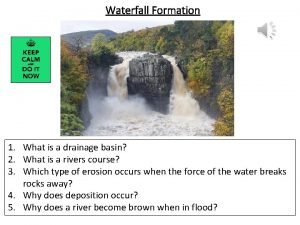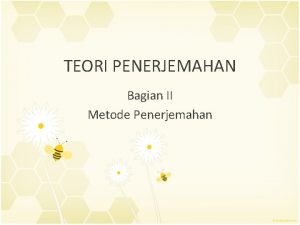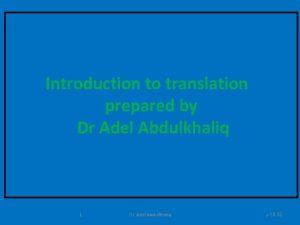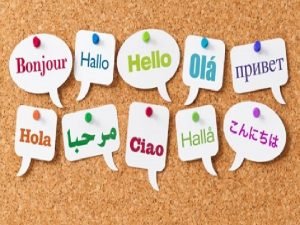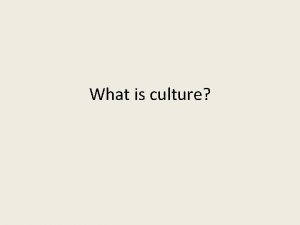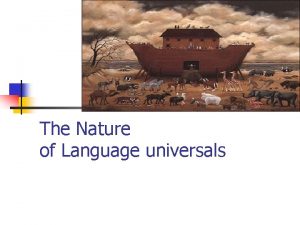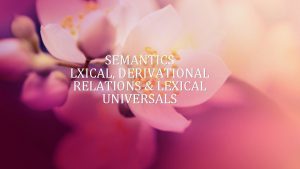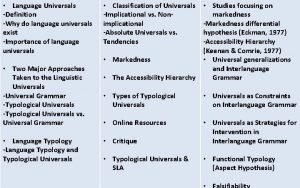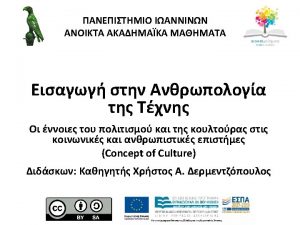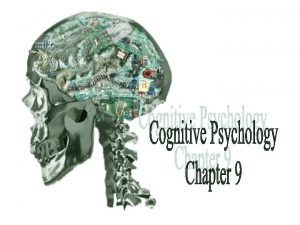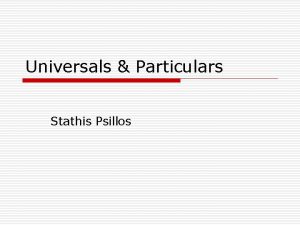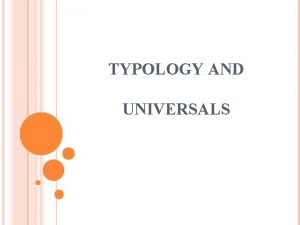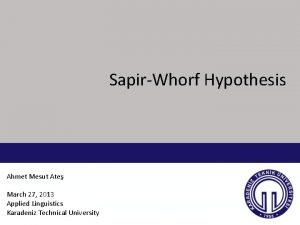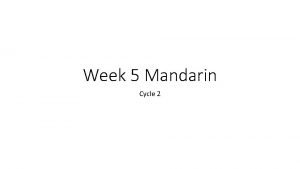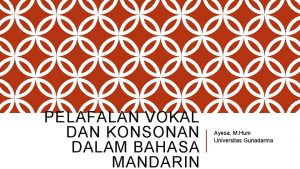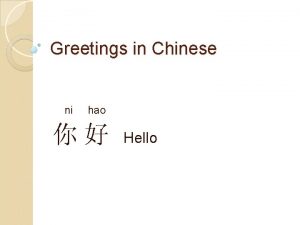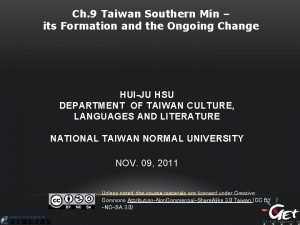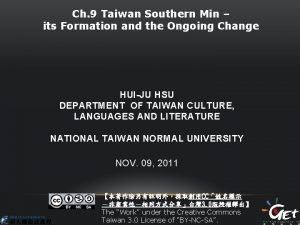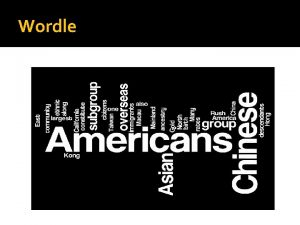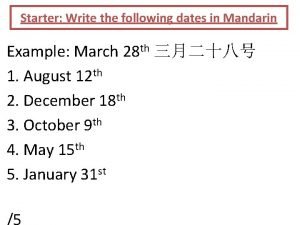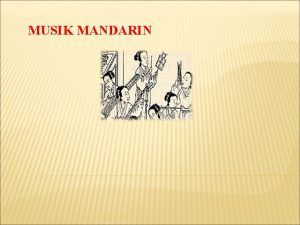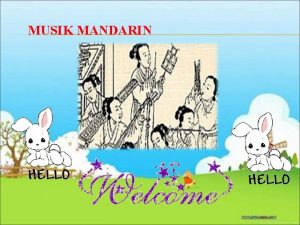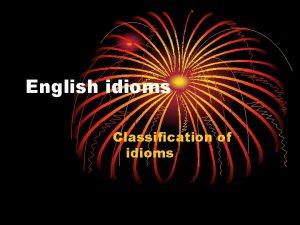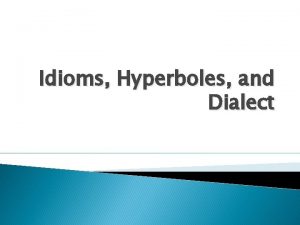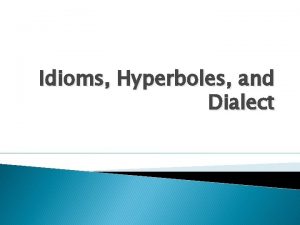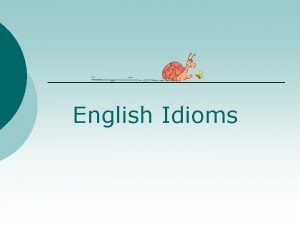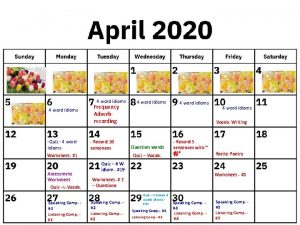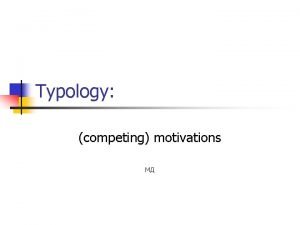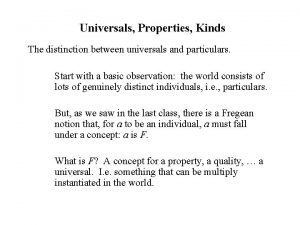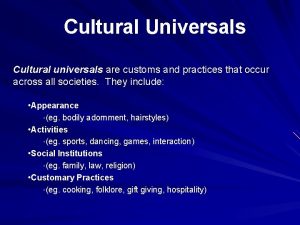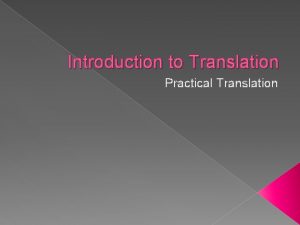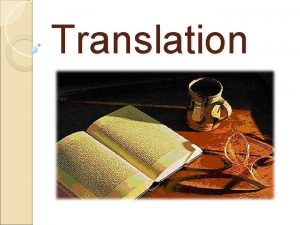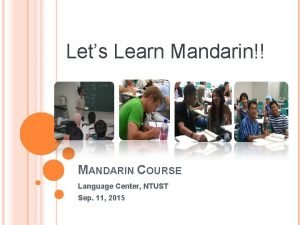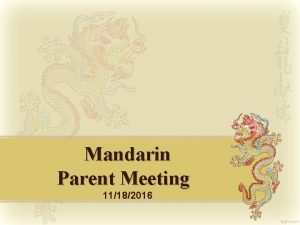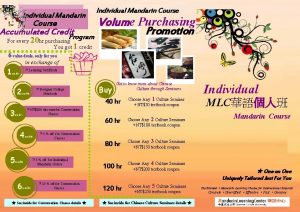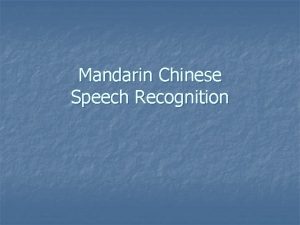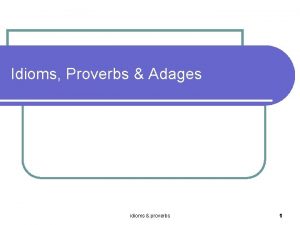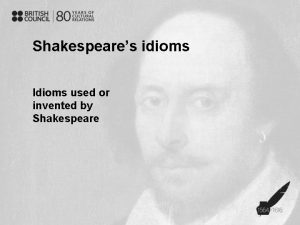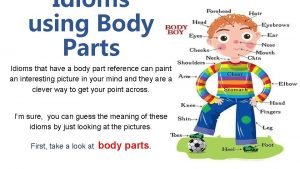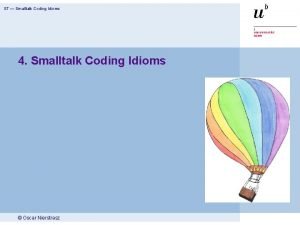Can translation universals survive in Mandarin Idioms word

























- Slides: 25

Can “translation universals” survive in Mandarin? Idioms, word clusters, and reformulation markers in translational Chinese Richard Xiao

TU: A focus of CBTS • An important area of corpus-based TS over the past decade – Baker (1993, 1996); Chesterman (2004); Kenny (1998, 1999, 2000, 2001); Laviosa (1998); Mauranen & Kujamaki 2004); Mc. Enery & Xiao (2002, 2007); Olohan (2004); Olohan & Baker’s (2000); Øverås (1998); Pym (2005); Xiao and Yue (2008), Xiao (2010) • Most prominent and pioneering work based on English data • “Translation universals” – – – Simplification Normalization Explicitation Sanitization Convergence / levelling out 2

TU: A target of debate • Is translational language different from target native language? • Translational language is at best an unrepresentative special variant of the target language because translations cannot possibly avoid the effect of translationese • e. g. Baker 1993; Gellerstam 1996; Hartmann 1985; Laviosa 1997; Mc. Enery & Wilson 2001; Mc. Enery & Xiao (2002, 2007); Teubert 1996; Xiao (2010) 3

TU: A target of debate • Are the features uncovered on the basis of translational English generalizable to other translated languages? • Existing evidence has largely come from translational English and related European languages • If such features are to be generalized as “translation universals”, the language pairs involved must not be restricted to English and closely related languages – Cheong’s (2006) study of English-Korean translation contradicts even the least controversial explicitation hypothesis • Evidence from “genetically” distinct language pairs such as English and Chinese is undoubtedly more convincing if not indispensable 4

The ZCTC corpus • The ZJU Corpus of Translational Chinese (ZCTC) was created with the explicit aim of studying the features of translated Chinese • A translational counterpart of the Lancaster Corpus of Mandarin Chinese (LCMC), a one-million-word balanced corpus of native Chinese (Mc. Enery & Xiao 2004) – www. ling. lancs. ac. uk/corplang/lcmc/ • Five hundred 2, 000 -word text samples taken proportionally from fifteen written text categories published in China in the 1990 s – www. ling. lancs. ac. uk/corplang/ZCTC/ 5

LCMC / ZCTC corpus design 6

Translated Chinese: Some observations • Laviosa’s (1998) classic findings of the four core patterns of lexical use in translational English are generally also applicable in translated Chinese (Xiao 2010) • Beyond the lexical level – Mean sentence length is sensitive to genre variation and may not be reliable as an indicator of simplification – A comparison of frequent conjunctions in native and translated Chinese shows that simpler forms tend to be used in translations – In spite of some genre-based subtleties, conjunctions are more frequently used in translational Chinese, providing evidence in favour of the explicitation hypothesis • Idiom, word cluster, reformulation marker 7

Previous findings of 3 features • Baker’s (2007) observations of idioms paint a mixed picture, pointing in two opposite directions – Translations are expected to make heavier use of idioms to confirm to the target language norm – Idioms, and opaque idioms in particular, are expected to be avoided in translations because of their informal flavour • Baker (2004) and Nevalainen (2005) find that recurring word clusters are more common in translations in comparison with non-translated texts • According to Baker (2004), RMs are substantially more frequent in translational than native English fiction; Chen (2006) also notes that RMs are more common in translated than native Chinese in the genres of popular science books 8

The issues • Previous findings are interesting but largely based on specific genres such as fiction and popular science writing while language can vary substantially across genres (cf. Biber 1995) – Scientific writing is the least diversified of all genres across various varieties of English (Xiao 2009) • Likely that what has been observed of idioms, word clusters and reformulation markers in the previous studies might be specific to particular genres rather than applicable to translational English or translational Chinese as a whole • It is also debatable whether the features uncovered on the basis of translational English can be generalized to other translated languages because of the nature of existing evidence 9

Idioms in LCMC & ZCTC • With a few exceptions (E, L, N - but the differences in E and N are not significant), idioms in native Chinese (LCMC) are considerably more frequent than in translated Chinese (ZCTC) • The overall frequency of idioms in LCMC (7979) is also much higher than in ZCTC (6265) 10

Idioms in translated Chinese • Balanced comparable corpora of translational and native Chinese appear to support Baker’s (2007) observation of the second tendency in translation to avoid idioms • This cross-linguistic contrast is probably a result of the different sources and functions of idioms in English and Chinese 11

Idioms in translated Chinese • Many Chinese idioms, especially the so-called 成� chengyu (typically four-character mould idioms), are historically allusive in origin, with stories from ancient times behind them, which often render them archaic in flavour and highly opaque in meaning (i. e. with their actual meaning different from their surface meaning) – Hence Chinese idioms other than those called 俗� suyu (‘common saying’) tend to carry a formal tone in style • In contrast, English idioms, especially those with an opaque meaning (e. g. kick the bucket), tend to have an informal flavour of slangs 12

Word clusters in LCMC & ZCTC Word clusters 2 -word clusters 3 -word clusters 4 -word clusters 5 -word clusters 6 -word clusters LCMC 21002 4015 580 160 70 ZCTC 23006 5523 732 197 105 LL 103. 44 248. 36 16. 58 4. 06 7. 25 p 0. 000 0. 044 0. 007 • Focusing on word clusters of 2 -to-6 words – Longer clusters are infrequent in million word corpora • Word clusters of all types are much more frequent in ZCTC than in LCMC – All differences are statistically significant 13

Word clusters in LCMC & ZCTC • The more frequent use of word clusters in translational Chinese is also evidenced by a keyword cluster analysis • For 2 -to-6 -word clusters, 958 clusters are significantly more frequent in ZCTC in contrast to 59 such clusters which are significantly more frequent in LCMC • For 3 -to-5 -word clusters, 123 clusters are significantly more frequent in ZCTC as opposed to just one such cluster which is significantly more frequent in LCMC 14

Word clusters in LCMC & ZCTC • In addition to their significantly higher frequencies in translational Chinese, word clusters also demonstrate two other interesting characteristics • High-frequency word clusters (>0. 01% of total corpus) are more common in translated Chinese (413 vs. 291, LL=21. 96, p<0. 001) • Word clusters have a much wider coverage in translated Chinese in comparison with native Chinese 15

A marked contrast showing an accelerating tendency as the coverage rate drops 2 -word clusters Similar because of the low overall frequencies 3 -word clusters 16

Word clusters in LCMC & ZCTC • The higher frequency and wider coverage of word clusters in translational Chinese suggest that translators demonstrate a higher propensity for striving for fluency than writers of native Chinese texts • There is also a sharp contrast in highest coverage rate between the two corpora – 2 -word clusters: 69. 8% in LCMC (的 一 ‘DE one’) vs. 79. 8% in ZCTC (不 是 ‘not be’) – 3 -word clusters: 19. 6% in LCMC (是 一 种 ‘be one kind’) vs. 27. 6% in ZCTC (而 不 是 ‘but not be’) 17

Word clusters in LCMC & ZCTC • Apart from the macro-level quantitative analysis above of frequency and coverage, a qualitative analysis of high-frequency word clusters at micro level also yields equally interesting findings • Some 2 -word and 3 -word clusters are frequently used in both native and translated Chinese • But there a much greater number of highfrequency word clusters which are unique in ZCTC than those which are unique in LCMC 18

Word clusters in LCMC & ZCTC • High-frequency 2 - and 3 -word clusters which are unique in ZCTC are mostly demonstrative structures (e. g. 这样 的 ‘this DE’) and modifying structures (e. g. 最 重要 的 ‘most important DE’) – Indeed, many of those demonstrative structures are also modifying structures • In contrast, high-frequency word clusters which are unique in LCMC seem to be mainly head structures (e. g. 的 发展 ‘DE development, the development of’) 19

Reformulation markers in LCMC & ZCTC Style Reformulation mark LCMC ZCTC Formal 即 267 274 (archaic) 换言之 5 8 也就是说 27 28 或者说 14 25 (colloquial) 换句话说/换句话讲 8 18 15 10 这就意味着 1 20 我的意思是 1 10 2 340 7 400 Informal 这就是说 更确切/准确/具体地说 Total Only RMs in a narrow sense, i. e. paraphrastic RMs are considered, which are generally more frequent in ZCTC than LCMC (LL = 4. 52, p=0. 033) 20

Formal vs. informal RMs • Both formal and informal RMs are more common in ZCTC – Frequencies of the formal forms of RMs in the two corpora are very close and not significant (LL=0. 127, p=0. 772) – Informal colloquial items are significantly more frequent in ZCTC than LCMC (LL=13. 31, p<0. 001) • In line with previous observations of formal and informal conjunctions in native and translational Chinese (Xiao & Yue 2009) 21

Conclusions • Idioms are significantly more common in native Chinese as a whole and also in nearly all genres, a finding different from Baker’s (2007) mixed findings based on English data • As the distribution patterns of idioms tend to be language-specific, the heavy use of idioms may not be a universal feature of translational language • The statistically significant quantitative contrast in the use of idioms in native and translational Chinese also tells a different story from the translation universal hypothesis of normalization 22

Conclusions • Word clusters are substantially more common in translational Chinese in terms of frequency, coverage, keyword clusters and as well nature • Translators tend to use fixed and semi-fixed recurring patterns which are purely structurally defined on the basis of their collocational behaviour in an attempt to achieve improved fluency • Translated texts also tend to be more similar to each other than to non-translated texts, which means that the universal hypothesis of convergence or levelling out is upheld in the light of evidence from Chinese 23

Conclusions • Our finding based on balanced comparable corpora of native and translational Chinese supports previous observations in some specific genres that RMs can function as an explicitation strategy • Translational Chinese generally makes more frequent use of informal colloquial RMs, but the distribution of formal markers seems to interact with the formality of genres, suggesting that translations are stylistically simpler than native Chinese texts • While explicitation is supported in translational Chinese, the patterns of RM use in translated Chinese also provide evidence in support of simplification and convergence but against the normalization hypothesis 24

Thank you! Richard. Xiao@edgehill. ac. uk 25
 Survive in mandarin
Survive in mandarin How waterfalls are formed
How waterfalls are formed Contoh penerjemahan komunikatif
Contoh penerjemahan komunikatif Last ayat of surah baqarah with english translation
Last ayat of surah baqarah with english translation Communicative translation
Communicative translation Modulation in translation
Modulation in translation Hrm jobs list
Hrm jobs list Greenberg universals
Greenberg universals Polysemy synonymy, hyponymy and antonymy
Polysemy synonymy, hyponymy and antonymy Absolute universals examples
Absolute universals examples Cultural universals
Cultural universals Holism anthropology definition
Holism anthropology definition Hockett's linguistic universals
Hockett's linguistic universals Particulars and universals
Particulars and universals Typology and universals
Typology and universals Linguistic universals
Linguistic universals Mandarin cycles
Mandarin cycles Vokal mandarin
Vokal mandarin üe
üe Zhongwen mingzi
Zhongwen mingzi Taiwanese mandarin
Taiwanese mandarin Taiwanese mandarin
Taiwanese mandarin Wordle mandarin
Wordle mandarin In the following dates
In the following dates Mandarin musik
Mandarin musik Diamant mandarin chant
Diamant mandarin chant

